Latest issue
All issues / Volume 19 (2025) / Issue 12 (December)
Jordi Puiggalí
Vol. 19., No.12., Pages 1214-1215, 2025
DOI: 10.3144/expresspolymlett.2025.89
Vol. 19., No.12., Pages 1214-1215, 2025
DOI: 10.3144/expresspolymlett.2025.89
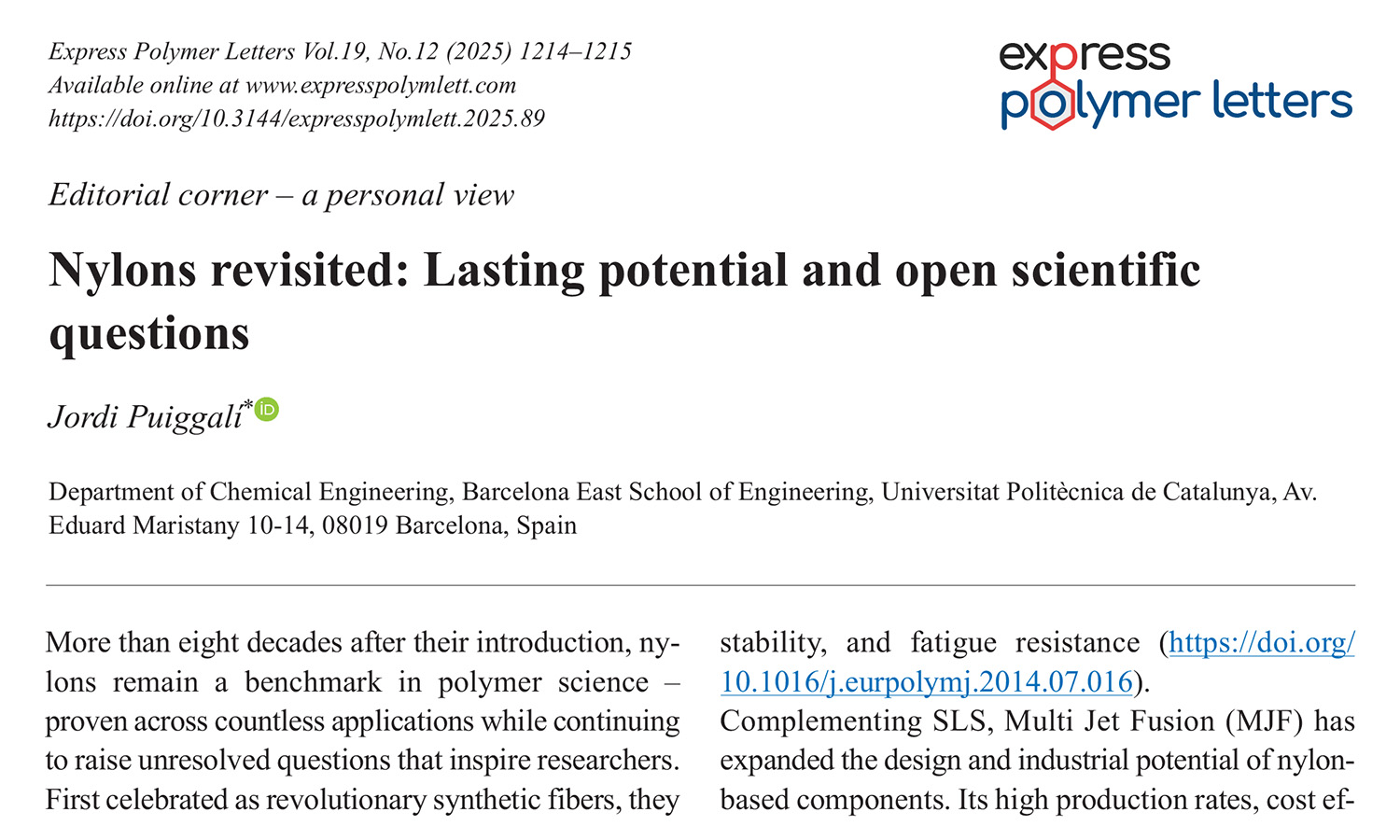
This is an editorial article. It has no abstract.
Marie Uth, Magnus Hansen-Felby, Jakob Rørbæk Saugbjerg, Andreas Sommerfeldt, Sunirmal Pal, Martin Lahn Henriksen, Steen Uttrup Pedersen, Kim Daasbjerg
Vol. 19., No.12., Pages 1216-1225, 2025
DOI: 10.3144/expresspolymlett.2025.90
Vol. 19., No.12., Pages 1216-1225, 2025
DOI: 10.3144/expresspolymlett.2025.90
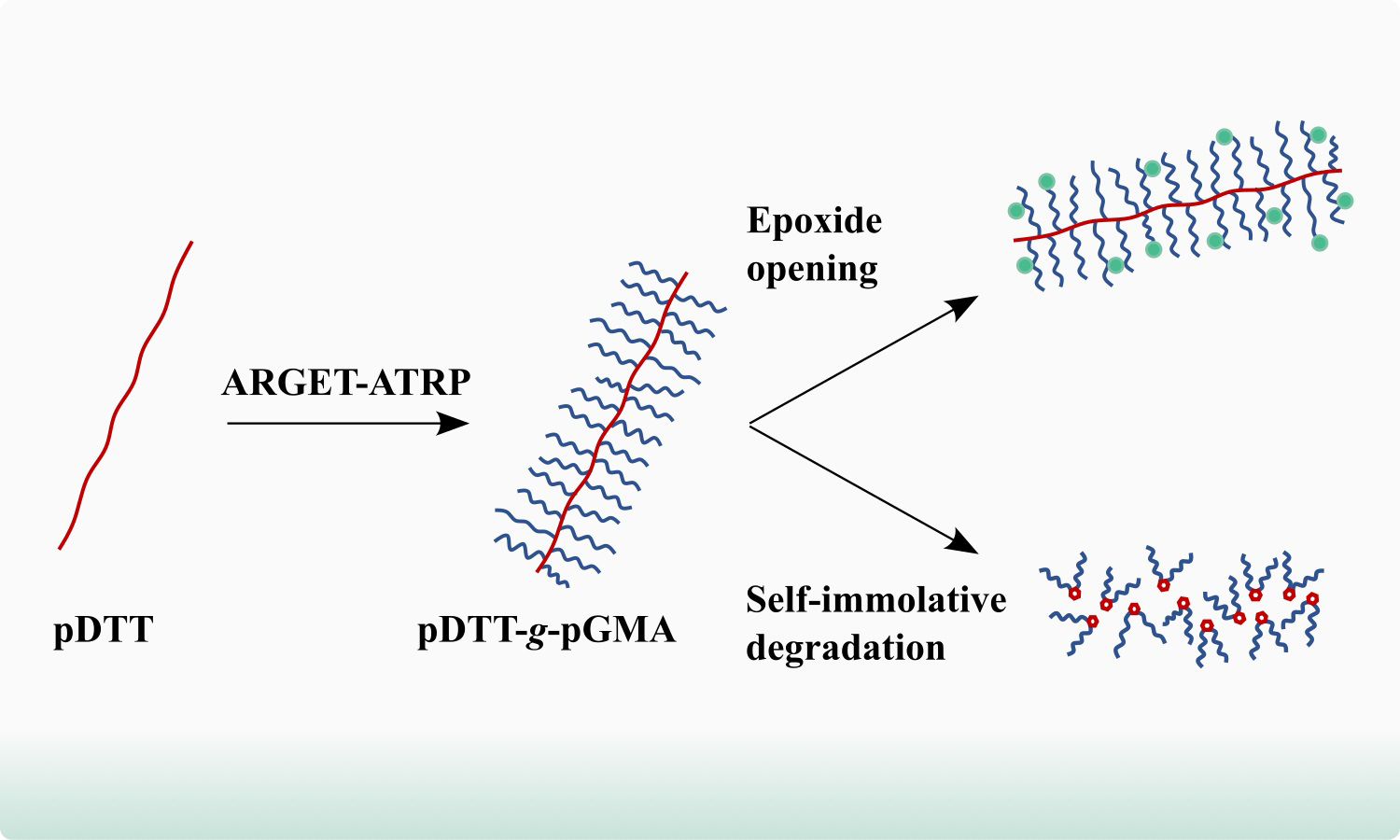
Post-polymerization modification of self-immolative polymers expands the application spectrum of such macromolecular materials. This work demonstrates grafting of poly(glycidyl methacrylate) brushes from a self-immolative poly(DL-dithiothreitol) backbone using activators regenerated by electron transfer–atom transfer radical polymerization (ARGET–ATRP). The polymerization kinetics of the brushes is studied in detail by 1H NMR and size exclusion chromatography, indicating a linear increase in number-average molecular weight. Furthermore, it is demonstrated that the self-immolative properties of the backbone are retained in the bottlebrush polymers by examining the degradation process in solution.
Marcelina Bochenek, Barbara Mendrek, Wojciech Wałach, Agnieszka Kowalczuk, Alicja Utrata-Wesołek, Agnieszka Fus-Kujawa, Natalia Oleszko-Torbus
Vol. 19., No.12., Pages 1226-1237, 2025
DOI: 10.3144/expresspolymlett.2025.91
Vol. 19., No.12., Pages 1226-1237, 2025
DOI: 10.3144/expresspolymlett.2025.91
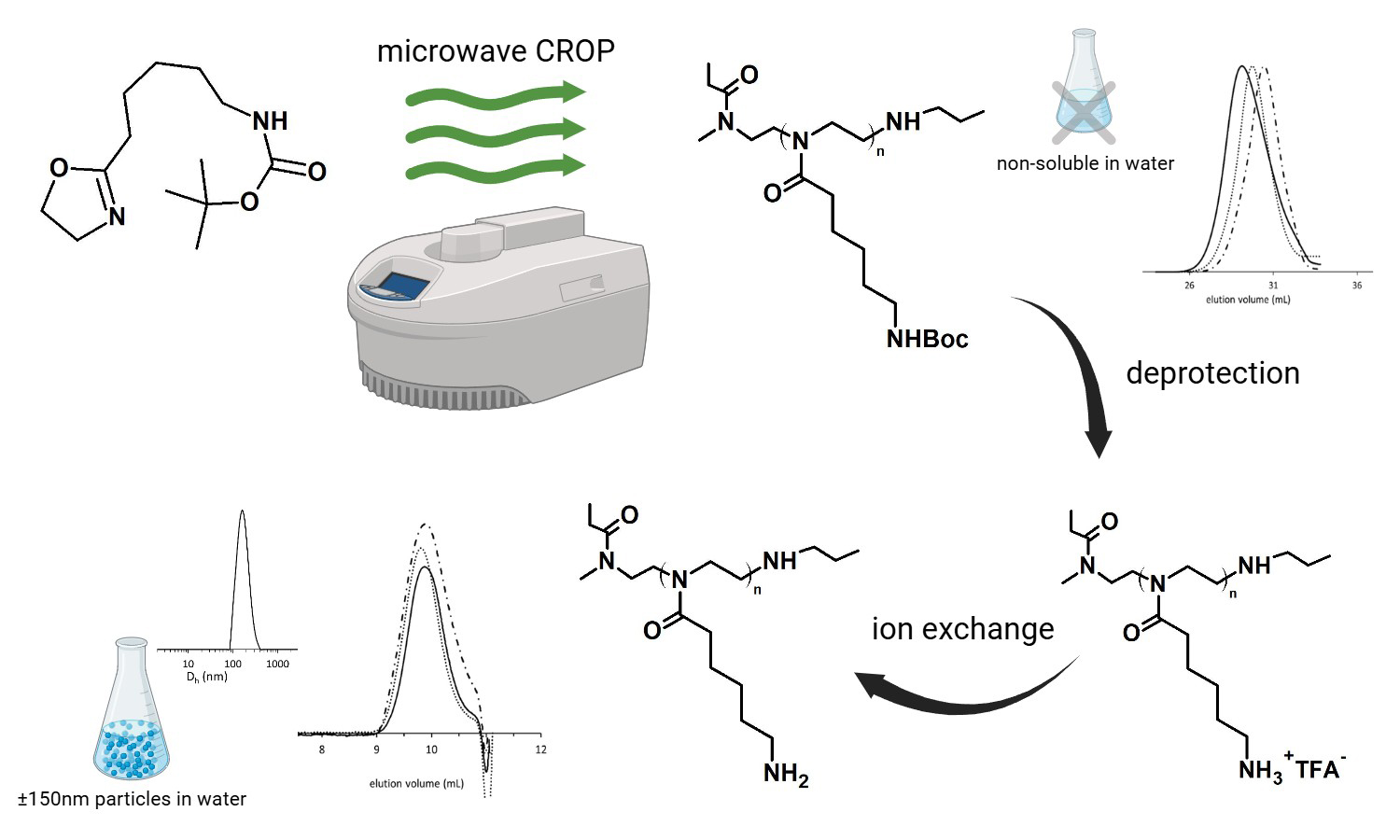
In this study, a series of novel homopolymers based on N-Boc-protected 2-(aminopentyl)-2-oxazoline (P(PentNHBocOx)) were synthesized via microwave-assisted cationic ring-opening polymerization (CROP), achieving high monomer conversions (up to 100%) and low dispersity values (Ð = 1.08–1.30). The resulting polymers were quantitatively deprotected using TFA/DCM, followed by ion exchange to yield amino-functionalized poly(2-oxazoline)s (P(PentNH2Ox)). Comprehensive characterization of the polymers confirmed successful deprotection without polymer degradation, preservation of low dispersity, and the formation of nanoscale aggregates in aqueous solutions falling within the size range of 140–152 nm, suitable, for biomedical applications. Cytotoxicity assays demonstrated that the polymers are non-toxic to human dermal fibroblasts, maintaining cell viability above 70% even at higher concentrations and extended incubation times. These findings highlight the potential of P(PentNH2Ox) as promising, biocompatible candidates for biomedical and nano-therapeutic applications.
Abdulaziz Al-Shehri, John Sweeney, Paul Spencer, Phil Coates, Fin Caton-Rose, Ajay Taraiya
Vol. 19., No.12., Pages 1238-1255, 2025
DOI: 10.3144/expresspolymlett.2025.92
Vol. 19., No.12., Pages 1238-1255, 2025
DOI: 10.3144/expresspolymlett.2025.92
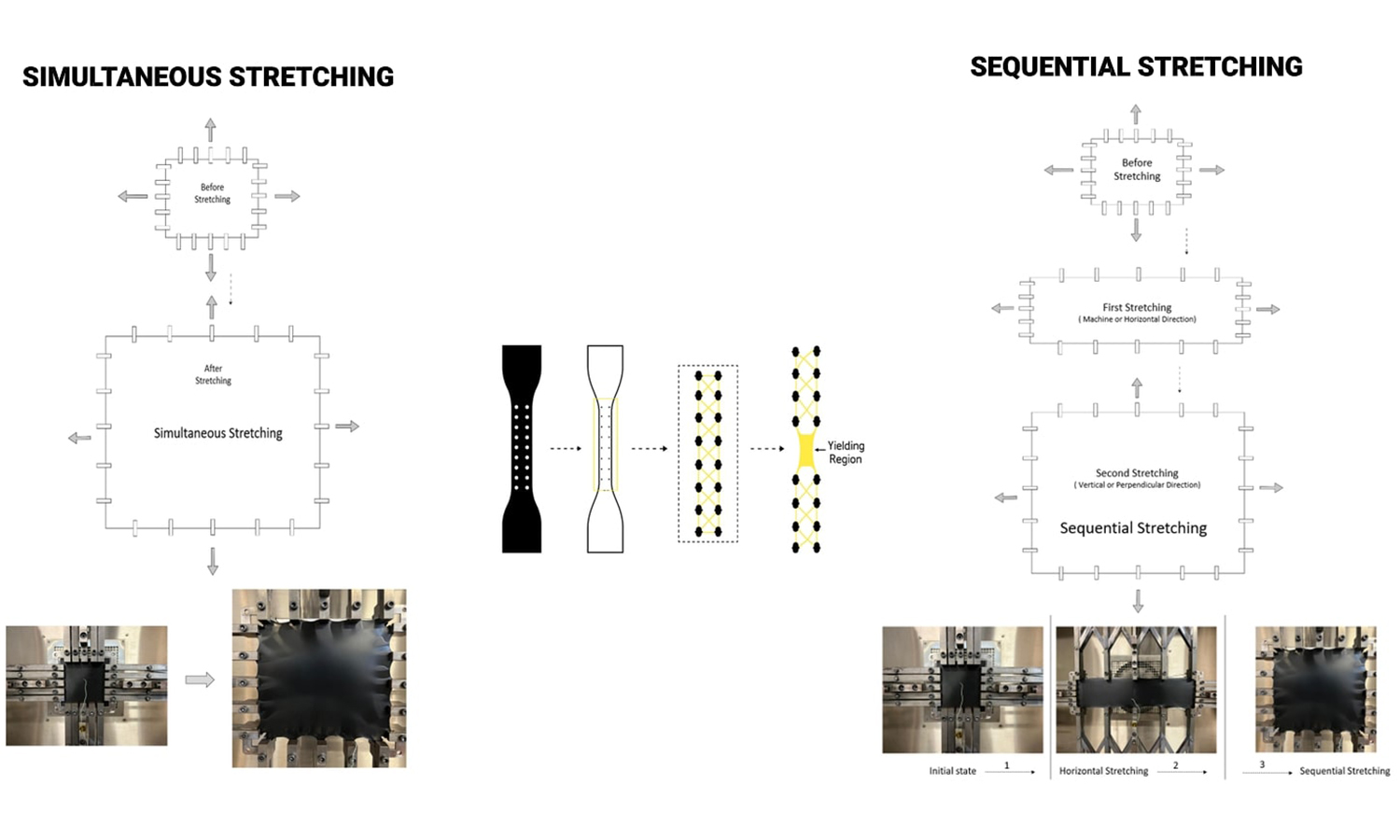
This study examines the combined effects of molecular modalities (unimodal, bimodal, trimodal) and biaxial stretching modes (sequential and simultaneous) on the yielding, stiffness, and necking behaviour of stretched high-density polyethylene (HDPE). Yield strength and stiffness were examined in relation to oriented material produced by drawing at linear strain rates 5.4·10–3, 2.2·10–2, and 8.6·10–2 s–1 under both stretching modes. Simultaneous stretching outperformed sequential stretching, with yield strength increasing with draw rate. Unimodal HDPE showed higher yield strength and stiffness than bimodal and trimodal grades, while trimodal HDPE had the lowest necking tendency from greater flexibility and uniformity. The highest necking tendency was observed in unimodal HDPE in strain localization analysis using the maximum strain/average strain ratio, while trimodal HDPE deformed more uniformly due to improved molecular weight distribution and strain hardening. Increasing the draw rate reduced strain localization, improving mechanical performance. Insights for optimising polyethylene materials in industry are provided by gel permeation chromatography (GPC), nuclear magnetic resonance (NMR) spectroscopy, and mechanical analyses, establishing the correlation between HDPE structure, processing, and properties.
Widtawad Reantong, Siriluk Chiarakorn, Muthita Vanaporn, Natee Srisawat
Vol. 19., No.12., Pages 1256-1273, 2025
DOI: 10.3144/expresspolymlett.2025.93
Vol. 19., No.12., Pages 1256-1273, 2025
DOI: 10.3144/expresspolymlett.2025.93

The development of functional antibacterial spunbond fabrics is critical for improving indoor environmental treatment. This study presents the fabrication of polypropylene (PP) fibers embedded with silane-modified Zr/Ag co-doped TiO2 nanoparticles. The Zr (5 mol%) and Ag (3 mol%) co-doped TiO2 nanoparticles were synthesized via a solvothermal method and subsequently modified with 5 wt% hexadecyltrimethoxysilane (HDTMS), referred to as ZATS5. The solvothermal method enables the controlled synthesis of phase-pure, well-dispersed nanostructures and facilitates dopant incorporation in the photocatalysts completely. Additionally, HDTMS surface modification improved compatibility with the polypropylene matrix, enhancing dispersion and interfacial bonding and improving overall composite performance. ZATS5 was incorporated into the PP matrix through melt spinning to produce composite fibers. The minimum of ZATS5 at 1 wt% embedded in spunbond nonwoven composite (PP/ZATS5-1) demonstrated the fiber’s structural integrity and remarkable antibacterial activity. The PP/ZATS5-1 nonwoven fabric achieved 99.98% inactivation of Legionella pneumophila under dark conditions and complete inhibition under visible light. This research offers a scalable and effective strategy for developing antibacterial spunbond nonwoven fabrics with potential applications in medical textiles, as well as air and water purification systems operating under ambient indoor lighting.
Wenhui Han, Yaqi Ge, Peng Wang, Haojun Zang, Shengqiang Xu, Huiguang Bian, Chuansheng Wang
Vol. 19., No.12., Pages 1274-1285, 2025
DOI: 10.3144/expresspolymlett.2025.94
Vol. 19., No.12., Pages 1274-1285, 2025
DOI: 10.3144/expresspolymlett.2025.94
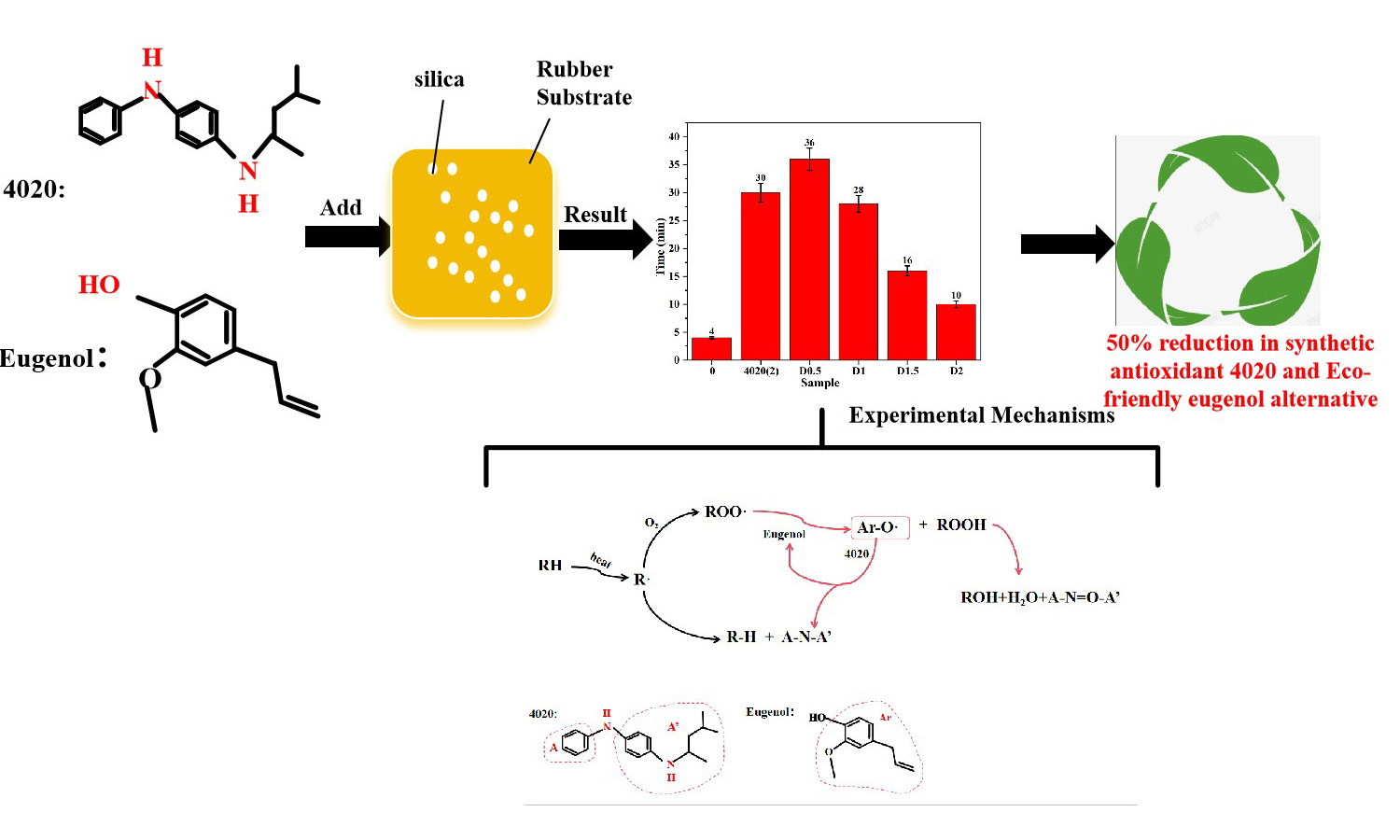
This study investigates eugenol as an alternative to mitigate environmental pollution and worker hazards associated with antioxidant N-(1,3-dimethyl)butyl-N′-phenyl-p-phenylenediamine (4020) while aligning with trends toward sustainable additives. Silica/natural rubber (NR) composites with varying ratios of eugenol and 4020 were prepared to assess their aging resistance, mechanical properties, and the synergistic antioxidant effects. Thermogravimetric analysis, cross-linking density experiments, thermo-oxidative aging tests, and oxidation induction tests revealed the highest thermo-oxidative aging resistance when 0.5 phr of 4020 was substituted with eugenol. When 1.0 phr of 4020 was replaced by eugenol, the antioxidant properties of the composites matched those containing 2.0 phr of 4020. However, when eugenol exceeded 1 phr, the antioxidant properties gradually decreased. DIN wear tests showed optimal wear resistance when 1 phr of 4020 was replaced with eugenol. These findings suggest that 50% of conventional antioxidants can be substituted with eugenol without compromising material properties. The partial substitution of eugenol in silica/NR composites proves eugenol can act as a sustainable alternative, providing comparable antioxidant capacity while reducing environmental impact.
Sandra Paszkiewicz, Kamila Sałasińska, Zaida Ortega, Mateusz Barczewski, Jacek Andrzejewski, Konrad Walkowiak, Izabela Irska, Magdalena Jurczyk Kowalska, Anna Boczkowska, Marcin Borowicz, Joanna Paciorek-Sadowska, Elżbieta Piesowicz, Katarzyna Pokwicka-Croucher
Vol. 19., No.12., Pages 1286-1309, 2025
DOI: 10.3144/expresspolymlett.2025.95
Vol. 19., No.12., Pages 1286-1309, 2025
DOI: 10.3144/expresspolymlett.2025.95
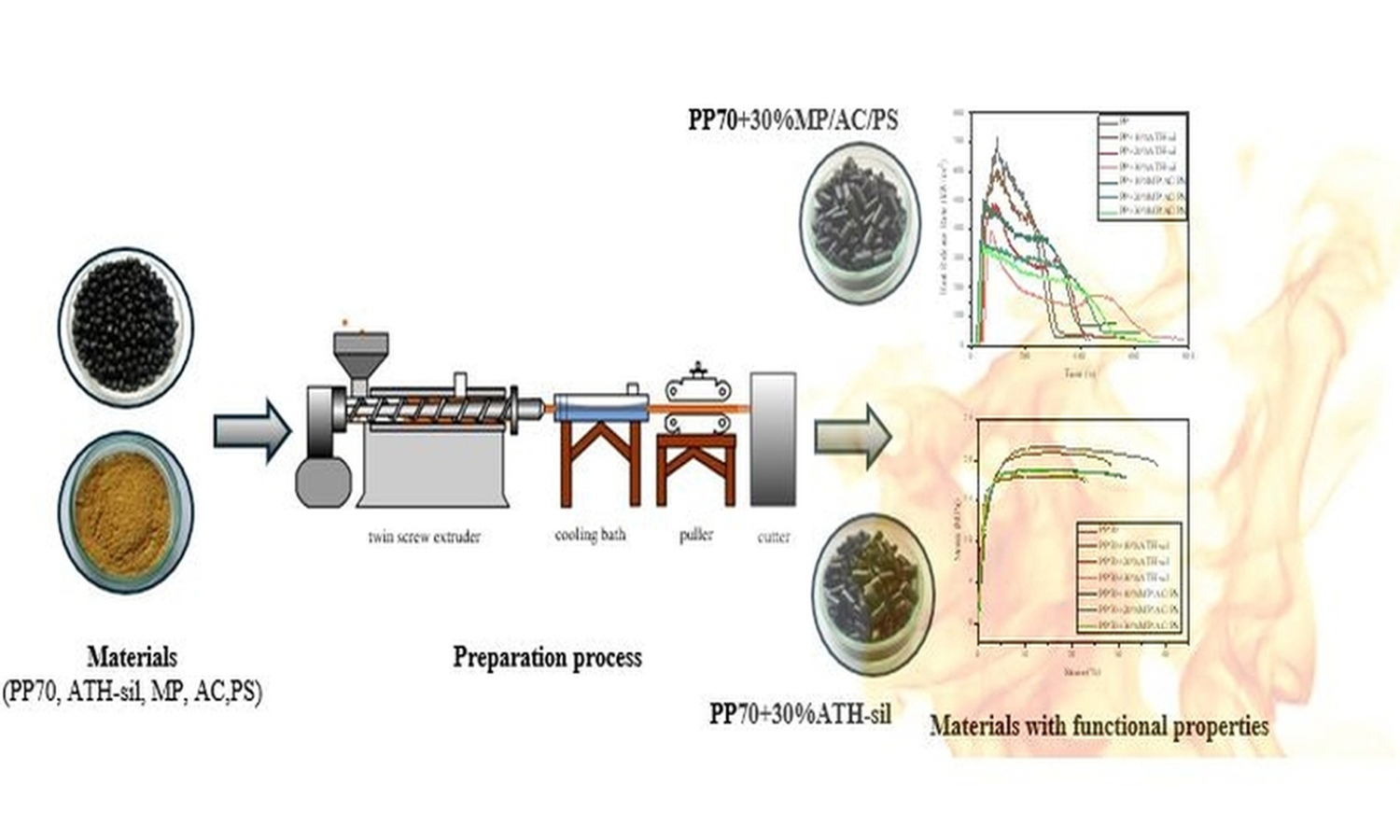
Two series of polymer blends based on post-consumer polypropylene (rPP) and tire rubber crumbs (Trc) under the trademark ECOPLASTOMER® PP70 with a mutual ratio of components 70/30 wt%, containing 10, 20, and 30 wt% of flame retardants, have been prepared using a twin-screw extruder. The influence of commercially available silane-treated alumina trihydrate (ATH-sil) with the eco-friendly system based on melamine phosphate (MP), aluminum hydroxide (AC), and peanut shells (PS), used as flame retardant agents, on the mechanical, thermal, and flammability properties of polymer blends was assessed – the incorporation of ATH-sil results in the appearance of peaks related to OH groups in the Fouriertransform infrared spectroscopy (FTIR) spectra. Similar observations are made for the MP/AC/PS system. differential scanning calorimetry (DSC) analysis revealed that using the selected flame retardants did not impact the melting and crystallization temperatures of the polymer. Tensile strength experienced a minor decrease, particularly in compositions containing more than 20 wt% of the flame retardants, while hardness remained unaffected by their share. Both flame retardants reduced the flammability of the modified polypropylene/rubber powder blends, and the most favorable outcomes were achieved with ATH-sil; however, only when employed at a minimum of 30 wt%. The formulated MP/AC/PS system proved more adept at reducing flammability and smoke emissions at lower flame retardant levels (up to 20 wt%).
Jutatip Makmanee Treitler, Diew Saijun, Kritsada Phatcharasit, Suwat Rattanapan
Vol. 19., No.12., Pages 1310-1319, 2025
DOI: 10.3144/expresspolymlett.2025.96
Vol. 19., No.12., Pages 1310-1319, 2025
DOI: 10.3144/expresspolymlett.2025.96
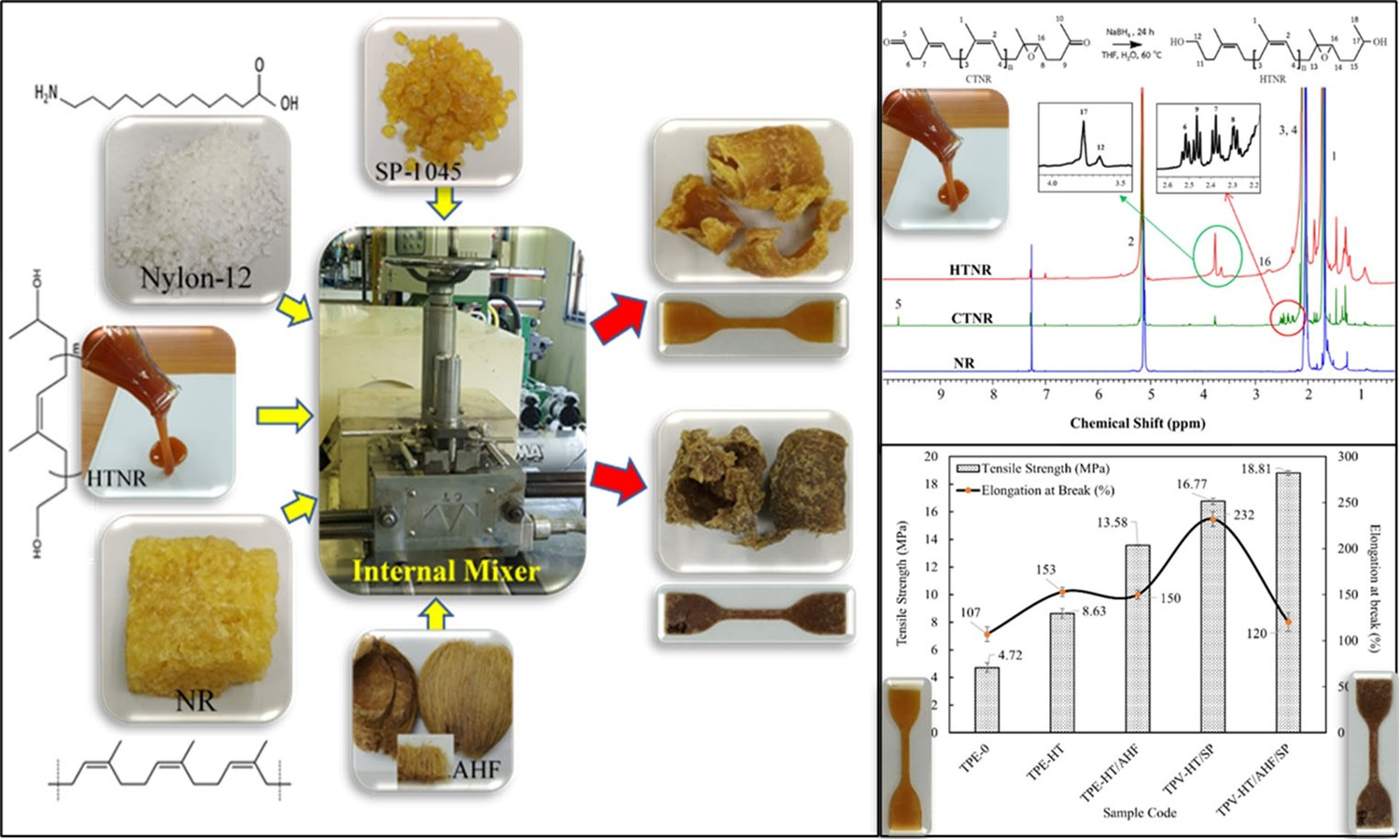
This work introduces an innovative method to enhance the compatibility of nylon-12/natural rubber thermoplastic elastomers by utilizing hydroxyl telechelic natural rubber as a reactive compatibilizer and natural fibers as reinforcement. Hydroxyl telechelic natural rubber was synthesized from natural rubber via oxidative cleavage to carbonyl telechelic natural rubber, followed by reduction with sodium borohydride. Proton nuclear magnetic resonance (1H-NMR) and Fourier transform infrared spectroscopy (FTIR) verified the structure. Incorporating hydroxyl telechelic natural rubber into nylon-12/natural rubber (40/60 wt%) blends significantly enhanced interfacial adhesion, improving tensile strength and elongation at break compared to the uncompatibilized mix. Dynamic vulcanization using phenolic resin achieved an optimal balance of strength and ductility. The incorporation of areca husk fiber enhanced tensile strength, hardness, and solvent resistance, with a slight decrease in ductility and tear strength. Rheological analysis indicated that hydroxyl telechelic natural rubber increased melt viscosity due to improved phase interactions, while dynamic vulcanization reduced the melt flow index through network formation. Solvent uptake experiments confirmed that hydroxyl telechelic natural rubber, areca husk fiber, and SP-1045 vulcanizing agent minimized swelling in isooctane, toluene, and diesel oil.


